![]() Line Profile Plot
Line Profile Plot
A Line Profile is a graph of pixel values versus distance along a line drawn on the image. A Line Profile differs from a Column Profile Plot and a Row Profile Plot in that the sample line is drawn manually using the mouse, In addition, the Line Profile plots intensity versus distance on the x axis, whereas a column or row profile plots intensity versus position. To change the line ("marker") this command draws on the image, see Marker Properties. See Creating a Line Profile for details about the line profile plotting procedure.
If the image has a World Coordinate System calibration, moving the pointer along the plot X axis reflects the world coordinates and pixel values along the drawn line.
Below is shown the Line Profile Toolbar,
which is a docking pane that controls most of the line profile
plotting functions. Note: Additional options are available from the
drop menu of the Line Profile button ![]() on the main Image Plot Toolbar. These are described in the
topic Creating a Line Profile.
on the main Image Plot Toolbar. These are described in the
topic Creating a Line Profile.
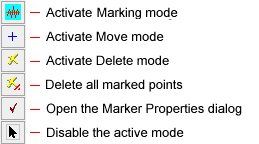
Additional properties may be set using the Line
Profile drop menu described below. above adds options to those on
the Line Profile Toolbar. It opens from the ![]() button on the main Image Plots
Toolbar.
button on the main Image Plots
Toolbar.
The line profile is drawn into a Plot Window like that shown below. Notice that the horizontal axis is distance, not an absolute position as used in Column Profile and Row Profile plots. The Plot Window below shows multiple parallel profiles on the head of a comet. These were made by switching to toolbar Move mode and repeatedly dropping the profile line further along the long axis of the comet head. The spike was caused by the profile line crossing a star.
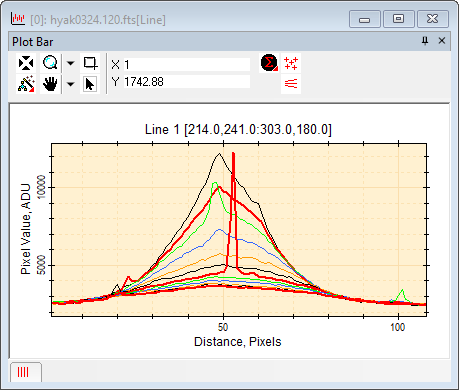
The Line Plot menu contains several commands from the toolbar plus commands for changing the plot properties.
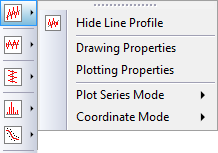
The procedure below uses two modes for creating line profile plots:
Mark mode creates a line profile plot in a new Plot Window. This creates the first plot of the window's plot series.
Add mode adds one or more parallel line profiles to the same Plot Window. These profiles add to the Window's plot series.
Adjust the image to the desired scale, showing the region to measure.
Click the ![]() button
on the Image Plot
Toolbar or use the Plot > Line Profile
Toolbar menu command to open the toolbar. Marking mode is
automatically enabled when the toolbar is first opened. To
reactivate Marking Mode it, click the
button
on the Image Plot
Toolbar or use the Plot > Line Profile
Toolbar menu command to open the toolbar. Marking mode is
automatically enabled when the toolbar is first opened. To
reactivate Marking Mode it, click the ![]() (mark) button at the top of the toolbar.
(mark) button at the top of the toolbar.
Move the mouse to the starting point. Press and hold down the left mouse button.
Tip: To draw a line only in multiples of 45 degrees, press the SHIFT key and hold it before starting to draw. Do not release the SHIFT key until after releasing the mouse button at the end of the line.
Tip: If Centroid First Point is checked in the Marker Properties dialog, the position will lock onto the local centroid near where the mouse is released.
With the left button down, drag the mouse pointer to the endpoint and release the button.
Tip: If Centroid Last Point is checked in the Marker Properties dialog, the position will lock onto the local centroid near where the mouse is released.
Tip: The results are displayed in a new Plot Window.
To create additional line profile plots:
Tip: To create a new profile in a new Plot Window, repeat the previous two steps.
Tip: To add parallel
profiles to the Plot
Window containing the last plot marked (steps 3 -- 4), enter
![]() (add) mode and click on a point in
the image. See Plotting Multiple Parallel Line
Profiles, below.
(add) mode and click on a point in
the image. See Plotting Multiple Parallel Line
Profiles, below.
When finished drawing profile lines, you can
disable marking mode by clicking ![]() on the
toolbar.
on the
toolbar.
|
TIP: |
To draw a line at a multiple of 45 degrees, press the SHIFT key and hold it before starting to draw. Do not release the SHIFT key until after releasing the mouse button at the end of the line |
Multiple parallel line profiles may be added to an
existing Plot Window
by repositioning the line plot vector at different image locations.
The new profile will pass through the new point. Each time you draw
a line plot vector using ![]() (mark) mode,
the line profile plot is drawn into a new Plot Window.
(mark) mode,
the line profile plot is drawn into a new Plot Window.
Press ![]() (mark) and
rubber-band the first line plot vector on the image. This draws the
line plot in a new Plot
Window as the first of a plot series of 1 or more profiles.
(mark) and
rubber-band the first line plot vector on the image. This draws the
line plot in a new Plot
Window as the first of a plot series of 1 or more profiles.
Press ![]() (add) and click on
an image point through which you want the parallel line plot vector
to pass. The line profile adds to the plot series started by the
(add) and click on
an image point through which you want the parallel line plot vector
to pass. The line profile adds to the plot series started by the
![]() button.
button.
Repeat step 2 to add parallel line profiles to the Plot Window.
To start a different line plot series in a new Plot Window, repeat step 1 and, optionally, steps 2 and 3.
The picture below shows an Image Window with 3
parallel lines drawn using the ![]() (mark)
and
(mark)
and ![]() (add) modes. First, the middle line
was drawn using the toolbar
(add) modes. First, the middle line
was drawn using the toolbar ![]() (mark)
mode. After switching to
(mark)
mode. After switching to ![]() (add) mode, two
parallel lines were added by clicking on the image to the right and
left of the first line. The two additional points were chosen so
that the profiles would pass through bright stars.
(add) mode, two
parallel lines were added by clicking on the image to the right and
left of the first line. The two additional points were chosen so
that the profiles would pass through bright stars.
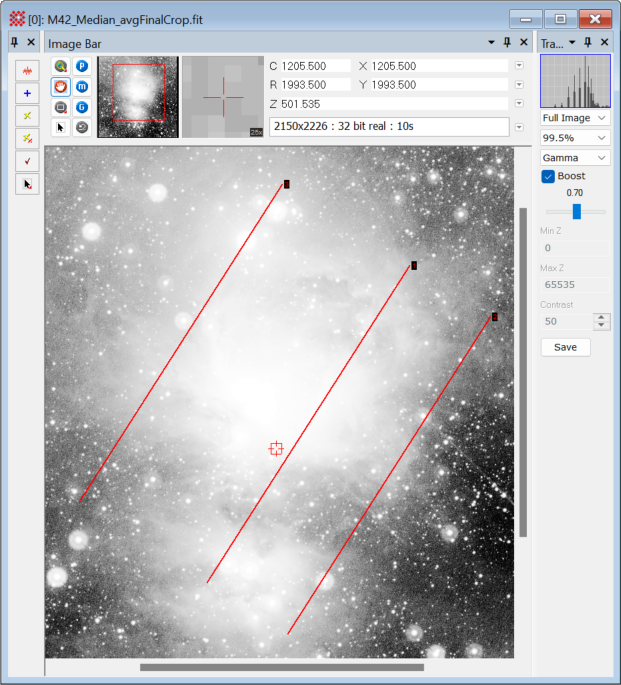
The 3 lines drawn in the image created a plot series of 3 line profiles in the Plot Window shown below. The first profile created a new plot series whereas the additional profiles added members to the plot series. The picture below shows the profiles in Overplot mode. Switching to Animate mode displays each profile separately, each with a unique title that lists the line endpoint coordinates from the image.
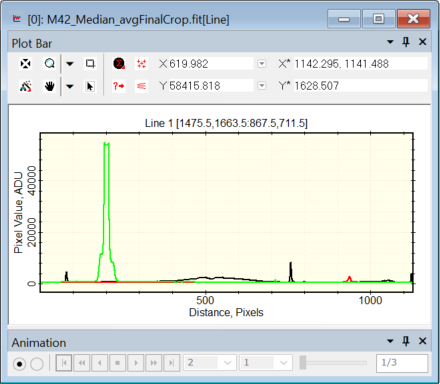
In this example, the plot series members are drawn with equal line thickness in black, red, and green for series 1, 2, and 3, respectively. For example, notice the green spike around x=200 corresponding to the bright star near the beginning of line 3 drawn on the image. These properties can be changed before or after creating the plots:
Before the first profile is drawn in a new Plot Window, the series properties are set using the Image Plot Properties dialog in the View > Default Properties menu.
After the first profile is drawn, the series properties can be altered using the Plot Series Pane which is opened using Ctrl+Shift+A or by right-clicking in the Plot Window.
Mira Pro x64 8.73 User's Guide, Copyright Ⓒ 2024 Mirametrics, Inc.
All Rights Reserved.